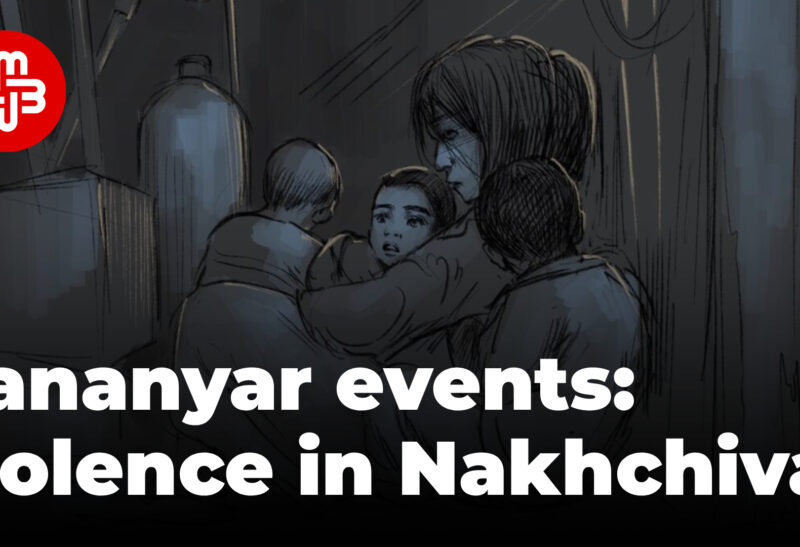To die, to be annihilated, to be wiped off the face of the earth … For years, I have written about death, as well as the pain of the loss of a loved one. I never thought that not only living beings could die, but cities as well…
When I heard that I was going to the liberated city of Fuzuli, I couldn't have imagined what would meet me there.
Background
: It all started when I heard that a trip to the liberated cities was being organized for journalists. First, I informed the Presidential Administration through an acquaintance that I wanted to join the visit. It didn't take long to receive an answer: "It's impossible, Meydan TV does not support our politics."
"Meydan TV does not support any politics," I had written. Again, I wanted to try my luck once more and wrote a message directly to the President's aide Hikmet Hajiyev, noting that I wanted to report on Fuzuli. This time it worked and I joined the ranks of journalists going to the city.

Traces of war
On the way to Fuzuli we were accompanied by a traffic police car. When we were told we had reached the area, we got off the bus and continued on our way in smaller "Sprinter" buses. Because of the condition of the dirt roads, our bus could not navigate well. The bus I was on had "Imishli" written on it, and the driver said that he was actually working on a city route in Imishli, but that he had been transporting soldiers to the area since 27 September. Then he pointed to the wreckage of a destroyed car on the right side of the road and said, "Look, this is the territory we have liberated from the occupation."
Traces of war could be seen on the plains as far as the eye could see. Along the way, there were destroyed trucks belonging to Armenian military units, burnt tanks, and holes formed by shells. There were also military uniforms, their bags, bandages, sleeping bags … Occasionally there were cartridges. All the small rocks were carved into trench-like structures and were believed to have been used by the Armenian military as a refuge.
At first glance, it was clear that before the war, Fuzuli had only been used for military purposes, not as a settlement. On the roads there was no sign indicating the name of the location, nor was there a building reminiscent of one.
It was also possible to determine from the dried weeds that they planted sunflowers in some areas. There were still poles in the vineyards built during the Soviet era.

An unexploded rocket, captured devices…
The journalists were first taken to the area where the phosphorus rocket was fired. The rocket had not exploded, it was to be destroyed by the staff of the National Agency for Mine Action (ANAMA), and we were to record this scene on our cameras. We gathered far away from the area, ANAMA director Gazanfar Ahmadov counted down from five and the shell was destroyed. White mist rose into the air. For those who had only seen war in films, this scene could be an ordinary, painless image…
Journalists were shown another device. Ahmadov said that the missiles fired from the facility, which belonged to the Armenian armed forces and were stored in the trench, had a range of 18 kilometers.
Among the captured devices were tanks and cars. The military unit belonging to the Armenian military units was completely full of weapons.

Fuzuli ruins
Our caravan finally headed to the center of the district. Ruined, dilapidated buildings and overgrown areas makes one ask themselves when people last lived here. There was only one sign of life along the way – a palm and fig tree behind a fallen fence and dried blackberry bushes on the fruit …
The Azerbaijani flag was flying over a semi-structure believed to be used as a headquarters by Armenian armed forces.

Destroyed graves, exploded headstones
We stopped on a muddy road full of ruins, and they said to us, "This is the center of Fuzuli." Almost everyone looked around in amazement. we were looking for a sign of life in this place we call a district, a city. Shortly afterwards, our new acquaintance Carlotta, from the New York Times asked me, "Were you also shocked by what you saw?"
It truly was a shocking sight. For a moment it seemed to me that this was a settlement that existed thousands of years ago and had now been discovered during excavations. However, just 27 years have passed since the occupation of Fuzli. Only 30 years ago, there was a city with a school, a kindergarten, a hospital, residential buildings, a mosque and a restaurant. No trace remains among the ruins.
Someone likened it to Chernobyl. No, it didn't look like that. As I saw in a film, in abandoned Chernobyl there were still buildings, houses, even a swing in the park. In that case, Fuzuli had been murdered, and the ruined pile of stones did not resemble its previous appearance. It was impossible to know whether a building was a house or an office building.

In front of one of the ruins, Hikmet Hajiyev spoke in Azerbaijani and English about Fuzuli's liberation from occupation, and vandalism committed by Armenians. Then, the head of the Fuzuli Municipal Head Ali Aliyev spoke about the life of the displaced people, their joy in the liberation of their cities, and praised the President. Two residents of the district stood in front of their old home and said glad to see it again despite it lying in ruins. From time to time, we heard Gazanfar Ahmadov remind us, "Do not go off the road, it is dangerous, there may be a mine".
I got distracted by the scene around me. I was hoping to hear at least one bird chirp on this rainy autumn day. After all, even in winter it is possible to hear birds searching for food. Yet there was no life in this dead city except for us.

Fuzuli was not a victim of the war that began on September 27. It was killed during the occupation 27 years ago. The Armenian government, which had once driven the people out of their homes, was unable to take make the city its own. And as if in spite, destroyed it. After all, one protects, lives, and builds the in the place one calls its own.
Of course, Fuzuli will be rebuilt and turned into a city again. Lands liberated and returned. But will the Karabakh problem be resolved once and for all? There is still no answer to this troubling question…






